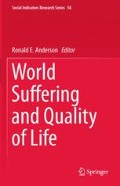Abstract
Hospice care takes a variety of forms across the world, though the philosophy of “being there” remains similar across locations. Within the hospice approach, the suffering of the declining person is often not isolated to that single individual. Family members, paid care staff, and other healthcare workers feel their own pain when they experience the suffering of others. This chapter uses U.S.-based hospice workers’ descriptions of “difficult patients” to illustrate how hospice workers’ identities are related to suffering that extends beyond patients (diffusion of suffering). I find hospice workers suffer most when patients’ lives bring out the workers’ greatest fears, when patients remind them of their own personal loss, and when patients’ experiences make ethical questions salient. Each condition challenges the meaning of hospice work and identities, creating distress in hospice workers.
Access this chapter
Tax calculation will be finalised at checkout
Purchases are for personal use only
References
Anderson, R. E. (2014). Human suffering and quality of life: Conceptualizing stories and statistics. New York: Springer.
Boss, P. (2007). Ambiguous loss theory: Challenges for scholars and practitioners. Family Relations, 56(2), 105–111.
Byock, I. (1996). The nature of suffering and the nature of opportunity at the end of life. Clinics in Geriatric Medicine, 12(2), 237–252.
Byock, I. (1998). Dying well: Peace and possibilities at the end of life. New York: Riverhead Books.
Cain, C. L. (2012). Integrating dark humor and compassion: Identities and presentations of self in the front and back regions of hospice. Journal of Contemporary Ethnography, 41(6), 668–694.
Cain, C. L. (2014). Orienting end-of-life care: The hidden value of hospice home visits. In M. Duffy, C. L. Stacey, & A. Armenia (Eds.), Caring on the clock: The complexities and contradictions of paid care work. New Brunswick: Rutgers University Press.
Charmaz, K. (1983). Loss of self: A fundamental form of suffering in the chronically ill. Sociology of Health & Illness, 5(2), 168–195.
Clark, D. (2007). End-of-life care around the world: Achievements to date and challenges remaining. Omega, 56(1), 101–110.
Corr, C. A. (2007). Hospice: Achievements, legacies, and challenges. Omega, 56(1), 111–120.
Gregory, D., & English, J. C. B. (1994). The myth of control: Suffering in palliative care. Journal of Palliative Care, 10(2), 18–22.
Hart, B., Sainsbury, P., & Short, S. (1998). Whose dying? A sociological critique of the ‘good death’. Mortality, 3(1), 65–77.
Hutchinson, T. A. (Ed.). (2011). Whole person care: A new paradigm for the 21st century. New York: Springer.
Kelly, M. P., & May, D. (1982). Good and bad patients: A review of the literature and a theoretical critique. Journal of Advanced Nursing, 7(2), 147–156.
Lynch, T., Connor, S., & Clark, D. (2013). Mapping levels of palliative care development: A global update. Journal of Pain and Symptom Management, 45(6), 1094–1106.
Neimeyer, R. A. (2014). Meaning in bereavement. In R. E. Anderson (Ed.), World suffering and the quality of life. New York: Springer.
Schulz, R., Hebert, R. S., Dew, M. A., Brown, S. L., Scheier, M. F., Beach, S. R., & Nichols, L. (2007). Patient suffering and caregiving compassion: New opportunities for research, practice, and policy. The Gerontologist, 47(1), 4–13.
Stedeford, A. (1987). Hospice: A safe place to suffer? Palliative Medicine, 1, 73–74.
Swetenham, K., Hegarty, M., Breaden, K., & Grbich, C. (2011). Refractory suffering: The impact of team dynamics on the interdisciplinary palliative care team. Palliative and Supportive Care, 9, 55–62.
Twycross, R. (2007). Patient care: Past, present, and future. Omega, 56(1), 7–19.
Yoder, G. (2012). Companioning the dying: A soulful guide for caregivers. Fort Collins: Companion Press.
Author information
Authors and Affiliations
Corresponding author
Editor information
Editors and Affiliations
Rights and permissions
Copyright information
© 2015 Springer Science+Business Media Dordrecht
About this chapter
Cite this chapter
Cain, C.L. (2015). Suffering and Identity: “Difficult Patients” in Hospice Care. In: Anderson, R. (eds) World Suffering and Quality of Life. Social Indicators Research Series, vol 56. Springer, Dordrecht. https://doi.org/10.1007/978-94-017-9670-5_7
Download citation
DOI: https://doi.org/10.1007/978-94-017-9670-5_7
Published:
Publisher Name: Springer, Dordrecht
Print ISBN: 978-94-017-9669-9
Online ISBN: 978-94-017-9670-5
eBook Packages: Humanities, Social Sciences and LawSocial Sciences (R0)

